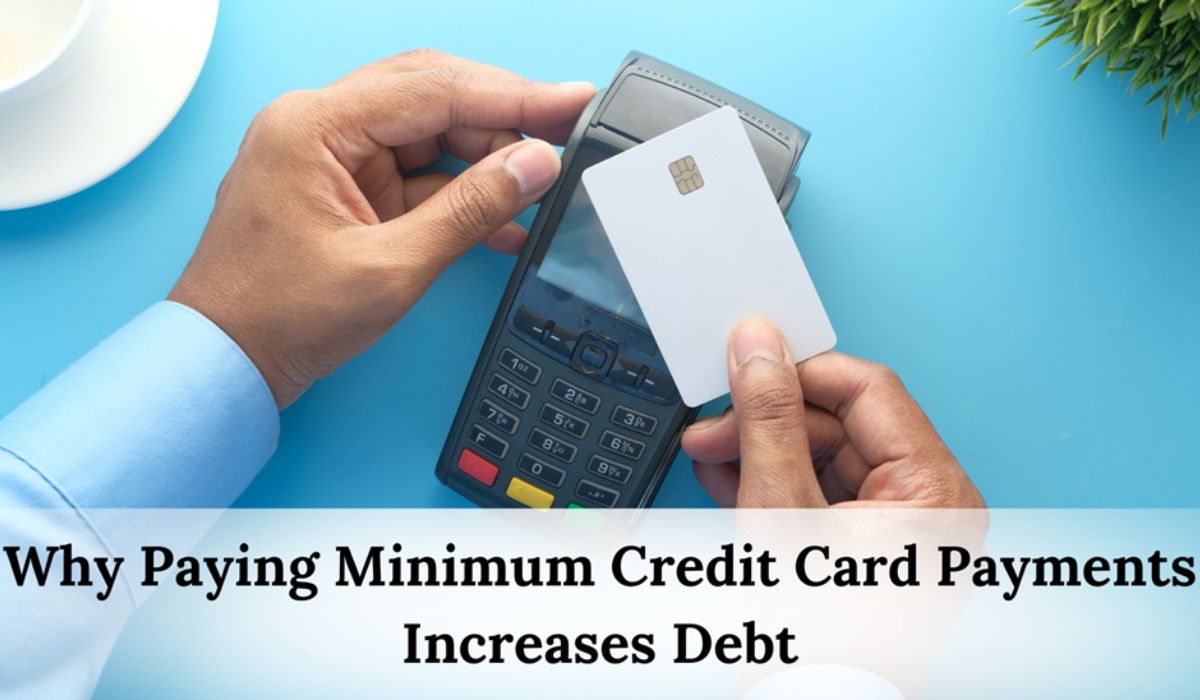BUSINESS
Why Paying Minimum Credit Card Payments Increases Debt

Have you thought about why your credit card balance seems stuck, even though you’re making payments every month? The answer might surprise you. Many people fall into the trap of only making minimum payments on their credit cards, not realizing the long-term consequences.
This practice can turn a manageable debt into a financial burden that lasts for years. In this article, we explore why minimum payments are problematic, how they increase your overall debt, and what you can do to break free from this cycle.
What Is a Minimum Payment?
A minimum payment is the smallest amount that your credit card issuer will accept toward your outstanding balance in a given billing cycle. This amount is typically a percentage of your total balance, often ranging from 2% to 4%, plus interest and any fees.
Some issuers may have a fixed minimum amount, such as $25 or $35 if the percentage-based calculation falls below this threshold. The exact calculation of minimum payments can vary between credit card issuers, but a common formula includes a percentage of the balance (e.g., 1%), plus interest accrued during the billing cycle, plus any fees (like late payment fees), or a fixed amount, whichever is greater.
For example, if you have a $1,000 balance with an 18% APR, your minimum payment might be calculated as 1% of $1,000 ($10) plus monthly interest ($1,000 x 18% / 12 months = $15), totaling a $25 minimum payment.
Understanding the minimum payment is crucial, but it’s equally important to know how to settle credit card debt if you find yourself overwhelmed by accumulating balances. Settling credit card debt involves negotiating with creditors to potentially reduce the total amount owed, which can provide relief if managed correctly. This approach might be necessary when minimum payments are no longer a feasible option and you’re looking for a way to regain financial stability.
The Appeal of Low Payments
Minimum payments can seem attractive because they appear affordable in the short term. For many people with tight budgets, the option to pay just $25 or $35 per month on a credit card balance seems like a manageable way to handle their debt. This perceived affordability can lead to a false sense of financial security.
However, this apparent affordability masks the true cost of carrying a balance and making only minimum payments. The reality is, by paying only the minimum, you barely cover the interest charges, let alone make a dent in the principal balance. This approach can lead to a long-term cycle of debt that becomes increasingly difficult to break.
The Mathematics of Minimum Payments
To grasp why minimum payments are problematic, consider a credit card with a $5,000 balance and 18% APR. With a minimum payment of 2% or $20, whichever is greater, the initial payment would be $100. At this rate, it would take over 34 years to pay off the debt, with a total payment of $14,423.12 – nearly triple the original balance.
The Impact of Interest
The dramatic increase in total payment is due to compound interest. Minimum payments primarily cover interest rather than reducing the principal balance. This slow balance reduction allows interest to accrue on a high balance month after month.
Over time, this compounding effect significantly increases overall debt. The result is a long-term financial burden that can take decades to overcome, illustrating the importance of paying more than the minimum whenever possible.

The Debt Spiral
Making only minimum payments can lead to a debt spiral that’s difficult to escape. As your credit card balance remains high due to minimum payments, your available credit decreases. This reduction in available credit can lower your credit score, potentially leading to higher interest rates on future loans or credit cards.
Additionally, the psychological trap of minimum payments can create a false sense of financial security. You may feel like you’re managing your debt responsibly by making regular payments, but in reality, you’re barely treading water.
This can lead to continued overspending and accumulation of debt. If the situation worsens, you might even find yourself sued for credit card debt, adding legal pressures to your financial burdens.
The long-term financial impact of this approach is significant. The money spent on interest over the years represents a substantial opportunity cost. Those funds could have been invested, saved for retirement, or used for other important financial goals. By making only minimum payments, you’re not just increasing your debt; you’re potentially sacrificing your long-term financial well-being.
Strategies to Break Free from the Minimum Payment Trap
Understanding the dangers of minimum payments is the first step; now let’s explore effective strategies to manage credit card debt more efficiently.
The most straightforward approach is to pay more than the minimum whenever possible. Even small increases can make a significant difference. For example, on a $5,000 balance at 18% APR, paying an extra $50 per month reduces the payoff time from 34 years to just under 4 years, saving over $8,000 in interest.
For those with multiple credit cards, the debt avalanche method is highly effective. This involves focusing on paying off the card with the highest interest rate first while making minimum payments on others. Once the highest-rate card is paid off, move to the next highest. This method minimizes the total interest paid across all cards.
If you have good credit, consider balance transfer options. Transferring high-interest balances to a card with a 0% introductory APR can provide breathing room to make larger payments towards the principal. Be aware of transfer fees and have a plan to pay off the balance before the introductory period ends.
Creating a budget and cutting expenses can free up additional money for credit card payments. Track your spending, identify areas to cut back, and consider ways to increase your income. Allocate any freed-up funds towards your credit card debt.
Lastly, don’t hesitate to negotiate with your credit card company. You might be able to request a lower interest rate, especially if you have a good payment history. Some issuers offer hardship programs for those facing temporary financial difficulties. Remember, the goal is to pay off your balance quickly to minimize interest and break free from the debt cycle.
| Strategy | Best For |
| Minimum Payments | Those in temporary financial difficulty |
| Fixed Higher Payments | Those who can afford to pay more |
| Debt Avalanche | Those with multiple debts |
| Debt Snowball | Those needing motivation |
| Balance Transfer | Those with good credit and a repayment plan |
The Importance of Financial Literacy
One of the reasons people fall into the minimum payment trap is a lack of understanding about how credit cards work. It’s crucial to read and understand your credit card agreement, including the Annual Percentage Rate (APR), how interest is calculated, fees associated with the card, and purchase grace periods.
Developing healthy financial habits is the key to breaking free from the cycle of debt. This includes living within your means by creating and sticking to a budget, using credit cards responsibly—ideally paying off the full balance each month—building an emergency fund to avoid relying on credit cards for unexpected expenses, and regularly reviewing your financial situation to adjust strategies as needed.
Conclusion
Managing credit card debt doesn’t have to be a struggle. By understanding the pitfalls of minimum payments and implementing smart repayment strategies, you can take control of your finances. Remember, every extra dollar you pay above the minimum makes a difference.
Start today by reviewing your credit card statements, creating a budget, and planning to pay more than just the minimum. Your future self will thank you for securing financial freedom.
Frequently Asked Questions
Are there alternatives to credit cards for emergency expenses?
Yes, alternatives include building an emergency fund, seeking personal loans from credit unions, or exploring community assistance programs for specific needs.
What’s the difference between secured and unsecured credit cards?
Secured credit cards require a cash deposit as collateral, while unsecured cards don’t. Secured cards are easier to get and can help build credit.
How often should I check my credit report?
It’s recommended to check your credit report at least once a year. You’re entitled to one free report annually from each of the three major credit bureaus.
Do I need a lawyer for credit card lawsuit?
A lawyer can be beneficial in a credit card lawsuit, especially if the debt is large or you have a valid defense. However, for small claims, you might represent yourself.
BUSINESS
Why Quality Should Be Your Priority in CC Shops

In the digital era, CC shops—platforms that facilitate the buying and selling of credit card (CC) information—have grown into a significant aspect of online commerce. However, with this growth comes a crucial decision ultshop for users and vendors alike: whether to prioritize quantity or quality. While the temptation to focus on sheer volume is understandable, quality should always take precedence. Choosing quality CCs is not just about avoiding losses; it’s about building trust, ensuring security, and sustaining long-term success. This article explores why quality should be your top priority in CC shops and the benefits it offers.
Understanding the Concept of Quality in CC Shops
Quality in CC shops refers to the reliability, authenticity, and usability of credit card information. High-quality CCs are verified, have low fraud risk, and are supported by legitimate financial institutions. They allow for smoother transactions, reduce the likelihood of chargebacks, and minimize the risk of getting flagged for suspicious activity.
In contrast, low-quality or unverified CCs often come with risks such as expired data, unauthorized use, or errors in transaction processing. These CCs may seem appealing due to lower costs or availability, but they often lead to financial loss and reputational damage. In the world of CC shops, the principle of “you get what you pay for” is particularly true.
Security and Fraud Prevention
One of the most important reasons to prioritize quality in CC shops is security. Fraud is rampant in digital transactions, and low-quality credit cards increase the risk of unauthorized activity. High-quality CCs, however, come with verification protocols and monitoring systems that safeguard both buyers and vendors.
Using verified and reliable cards protects your operations from potential fraud, reduces the risk of chargebacks, and ensures that transactions are legitimate. By focusing on quality, you create a secure environment that safeguards your financial interests and the trust of those you do business with.
Building a Positive Reputation
Reputation is everything in the digital credit card marketplace. Vendors who prioritize quality over quantity are viewed as trustworthy, responsible, and professional. Customers are more likely to return to a seller known for providing high-quality CCs, while businesses that focus on low-quality or unverified cards risk being flagged as unreliable or fraudulent.
A strong reputation built on quality leads to long-term relationships with customers and other vendors. In competitive markets, this trust is invaluable—it encourages repeat business, positive reviews, and word-of-mouth referrals, all of which contribute to sustainable success.
Minimizing Financial Risks
Using low-quality CCs can lead to significant financial losses. Failed transactions, chargebacks, and blocked accounts ultshop.mobi are common consequences when dealing with unverified or fraudulent credit cards. Each failed transaction represents not only a lost opportunity but also potential fees and complications for the user or vendor.
High-quality CCs, on the other hand, are verified and less likely to trigger issues during processing. This reduces financial risks and ensures smoother operations, allowing users to focus on growth and efficiency rather than constantly managing problems caused by poor-quality cards.
Enhancing Transaction Efficiency
Quality credit cards facilitate faster, smoother, and more reliable transactions. Verified CCs are compatible with secure payment gateways and often come with features that prevent errors or interruptions during processing. This efficiency benefits both the buyer and the seller, ensuring that transactions are completed without delay or complication.
In CC shops where speed and reliability are valued, focusing on quality can enhance user experience and maintain operational consistency. Customers are more likely to engage with vendors who provide seamless transactions, reinforcing loyalty and trust.
Legal and Ethical Considerations
Prioritizing quality is not only a matter of security but also of legality and ethics. High-quality CCs come from legitimate sources and are typically verified for authorized use. Using or selling low-quality, unverified, or stolen credit card information can expose vendors and buyers to criminal liability and legal repercussions.
By focusing on quality, you operate within legal and ethical boundaries, which strengthens your credibility in the market. Vendors and users who respect legal frameworks are more likely to develop sustainable operations and avoid the significant risks associated with illicit activities.
Long-Term Sustainability
Focusing on quantity over quality may provide short-term gains, but it is rarely sustainable. Low-quality CCs increase the likelihood of disputes, blocked accounts, and financial loss, which can jeopardize your ability to continue operations.
Quality, however, ensures long-term stability. Verified and reliable CCs reduce operational risks, minimize disputes, and maintain the trust of customers and partners. For anyone seeking sustainable success in CC shops, quality is the foundation on which long-term growth is built.
Differentiation in a Crowded Market
The CC shop ecosystem is competitive, with numerous vendors offering similar products. In such a market, quality becomes a key differentiator. Vendors who focus on providing verified, high-quality CCs stand out as reliable and professional, while those who prioritize quantity risk being overlooked or labeled untrustworthy.
Platforms that emphasize quality, such as UltShop, illustrate how prioritizing verified and reliable credit cards can create a competitive edge. Customers and partners gravitate toward platforms known for high standards, ensuring repeat business and positive market recognition.
Encouraging Responsible Practices
Prioritizing quality fosters responsible practices among both buyers and vendors. High-quality CCs encourage careful verification, secure handling of information, and ethical behavior in transactions. This responsible approach reduces the prevalence of fraud, promotes accountability, and contributes to a safer online credit card ecosystem overall.
By setting a standard for quality, vendors can influence the behavior of others in the market, promoting higher standards and reducing the risks associated with low-quality CCs.
Conclusion
Quality should always be your priority in CC shops. While the allure of quantity may seem tempting, focusing on high-quality, verified credit cards ensures security, enhances reputation, minimizes financial risks, and fosters long-term sustainability. High-quality CCs provide reliable, efficient transactions, demonstrate professionalism, and encourage ethical behavior.
In an increasingly competitive and high-risk environment, quality acts as a safeguard and a differentiator. Vendors and buyers who prioritize quality build trust, establish credibility, and position themselves for long-term success. Platforms like UltShop exemplify this approach, showing that prioritizing quality over quantity is not just a strategy—it is the cornerstone of a responsible and prosperous digital marketplace.
Ultimately, choosing quality CCs is about more than completing transactions—it’s about protecting your reputation, maintaining ethical standards, and ensuring a sustainable path forward in the complex world of CC shops.
BUSINESS
How to Choose the Best Movers in Montreal: 7 Essential Criteria

A great group of Déménageurs Montréal can make the difference between a smooth and friendly move or a nightmare of an experience where your furniture is lost, broken, or worst of all insured for pennies on the dollar. Movers Montreal Whether you are moving locally in the city or preparing for a long distance move, hiring reputable Movers in Montreal is one of the best decisions you will make. From the high-rise apartments in downtown to the quiet, suburban streets of its boroughs, Montreal’s neighborhoods are all unique and present their own challenges in which apartment locators should be experienced renters. This guide features seven key guidelines that will help you in making an informed decision in choosing the right Moving Services for you.
1. Check Licensing, Insurance, and Legal Compliance
When you are making a choice of reliable Movers in Montreal – make sure the first step is checking their license and insurance. Any reputable moving companies doing business in Quebec need to be registered with the “Commission des transports du Québec (CTQ)” and abide by the laws of the province. Movit is also reputable movers for Toronto that provide liability coverage to your stuff, so you have a reassurance that your belongings would be safe anyways. When you are researching companies to work with for Moving Montreal, be sure that they can provide you with proof of their general liability insurance as well as their cargo protection. This protects your stuff and also the company’s transparency and professionalism.
2. Evaluate Experience and Local Expertise
A mover’s experience is one of the best predictors of trustworthiness. Montreal is a city of singular diversity that has its fair share of deserted streets and alleys, steep staircases and heritage buildings — all making the transit process harder. Picking Movers Montreal who are familiar with these local situations will make your move a lot faster and easier. Find companies that have been around for a while, with hundreds of moves under their belt and smart residential and commercial Move Work. Professional movers are experienced in moving fragile items, maneuvering through busy cities, and dealing with less than ideal loading circumstances – this all adds up to peace of mind for you.
3. Review Customer Feedback and Online Reputation
Google Reviews, social sites and consumer websites are also helpful to gain a read on how a company is doing. If you are assessing your options for Moving in Montreal, take a moment to browse through customer feedback related to aspects like punctuality, professionalism, and overall customer-service. Be sure to listen for how businesses handle negative feedback; this will give insight into their commitment to customer service. The best Movers in Montreal always maintain trustworthy work ethic as well as a tendency to communicate effectively and handle every client’s belongings with respect. You can even direct to the company for testimonials whom you want take their services.
4. Compare Pricing, Quotes, and Service Transparency
Affordable and trustworthy movers in Montreal provide you with upfront moving quotes, without any hidden fees. When you’re collecting estimates, the other thing you should do is request for an itemized list of everything fees — including travel time, packing supplies, handling large or bulky items and additional services. Price shouldn’t be the only deciding factor, but transparent pricing is a must. Beware of too low quotes though — they can signal inexperience, or hidden costs. Rather than just one, get multiple free quotes from 3-5 Movers in Montreal so that you can make a more informed decision when selecting an affordable moving company, while still retaining the very best service possible.
5. Evaluate the Range of Moving Services Offered
Every move is different. Some clients want everything done for them, others just need to be carried. Prior to deciding upon a service of Moving in Montreal, verify which are the services which are part of their bundle. Some long-distance companies offer packing and unpacking, furniture disassembly and reassembly, as well as storage for between homes and specialty options such as handling of a piano or taking care of an antique. Services de déménagement And Their Offerings, The broader range of services you have access to the more it is possible for your move to be tailored to your personalized requirements. A business that is able to accommodate any last minute changes, or special requests, in my opinion is demonstrating flexibility, efficiency and superior customer service.”.
6. Inspect Equipment, Vehicles, and Safety Standards
A reputable moving company will also have clean reliable trucks, good packing supplies, and the right equipment including dollies, straps, and blankets. Regarding Movers in Montreal, find out about what kind of vehicles they have and how your goods will be protected while on the road. Professional services teams are all forced by their companies to practice safe protocols, use the right tools for the job, and adhere to proper lifting methods prevent damage. Nice and tidy equipment generally says something about the professionalism and quality of the company.
7. Assess Communication and Customer Support
Good communication is another major component for a successful move that remains free of stress. Quality moving service providers offer good customer support and a written estimate, and allow you an open channel for communication with all concerned parties during the move. While you’re in the process of comparing Moving in Montreal, it can be good to gauge response times as well as how well they answer questions. Good movers will go over timelines, specific details you may have, potential obstacles and more in the hopes that you will stay relaxed and prepared on moving day.
Final Thoughts
Finding the perfect Movers in Montreal demands extensive investigation and comparison. With consideration to licensure, experience, reputation, pricing, services offered, equipment and communication you can confidently choose a company for a stress-free transition to your new home. No matter if you are transitioning across the town, or to another province, when you choose the best team for Déménageurs Montréal, your stuffs will always be treated and taken care of with professionalism.
BUSINESS
Top Reasons to Shop Directly from Certified European Product Distributors

Shopping directly from certified European product distributors offers many benefits for customers who want quality, reliability, and transparency. These distributors follow strict standards that help build trust between sellers and buyers. When you buy from a certified source, you know the products come from verified channels and go through proper checks. This makes your shopping experience safer and more satisfying.
Why Authenticity Matters When Shopping Online
One of the main reasons people prefer certified distributors is the strong focus on authenticity. Many products in the global market face issues like imitation, altered packaging, or unclear sourcing. Certified distributors help solve these problems by offering products that come straight from approved manufacturers or verified suppliers. This ensures that customers always get real, high‑quality goods without worrying about fake or low‑grade items.
How Certified Distributors Maintain Quality and Consistency
Certified European distributors follow strict rules to maintain the quality and consistency of their products. They are required to store, handle, and ship goods in proper conditions. They also undergo routine checks and evaluations. This helps keep every product in fresh and safe condition before it reaches the customer. These practices improve the overall value of the products and make buying from certified sources more reliable.
Why Customers Prefer Platforms with Clear and Transparent Policies
Many customers feel more comfortable buying from platforms that offer clear details about their sourcing, delivery process, and customer support. Websites like https://mooiproduct.nl/ provide open information about product origins, pricing, and ordering steps. This transparency helps buyers feel secure and confident. When a store openly shares its policies, it becomes easier for customers to make informed decisions.
How Buying Directly Saves Time and Reduces Extra Costs
Purchasing from certified European distributors can also help you save both time and money. When you buy directly, you avoid extra layers of middlemen or resellers. This often leads to better prices and quicker delivery options. It also reduces the risk of delays, incorrect orders, or handling issues. Direct buying keeps the process simple and smooth, especially for customers who value efficiency.
Benefits of Working with Distributors That Prioritize Customer Satisfaction
Quality distributors also invest in strong customer service. They respond quickly, solve problems, and update customers throughout the ordering process. Their goal is to make sure each buyer has a positive experience from the moment they place an order until the delivery arrives. Good communication and reliable service make the shopping journey more enjoyable.
Key Advantages of Choosing Certified Distributors
Shopping from certified European product distributors offers many practical benefits for customers. Under this section, the main advantages are highlighted clearly.
- Secure and trusted product sourcing
- High standards for product handling and packaging
- Faster and more reliable delivery options
- Transparent pricing without hidden charges
- Responsive customer service teams
- Consistent quality in every order
- Better overall value for long‑term customers
The Importance of Verified Storage and Handling Methods
Certified distributors often follow strict storage and handling rules to preserve the condition of the products. This includes temperature‑controlled environments, careful packaging, and the use of proper transport methods. These steps ensure that items remain in excellent condition from the warehouse to your doorstep. Customers appreciate knowing that each product is handled with care and attention.
How Direct Shopping Helps Build Long‑Term Trust
Over time, buying directly from certified distributors builds strong trust between the store and its customers. When buyers receive consistent quality and timely service, they feel more confident returning again. This long‑term trust benefits both the distributor and the customer. It encourages a stable and positive buying experience.
Why Certified European Distributors Stand Out in the Market
In today’s busy online market, certified European distributors continue to stand out because of their dedication to quality, honesty, and smooth service. Their commitment to high standards makes them a smart choice for customers who want dependable products, fair prices, and secure shopping. By choosing certified distributors, customers enjoy peace of mind and a better overall online shopping experience.
Conclusion
Shopping directly from certified European product distributors offers a safe, reliable, and transparent way to buy high-quality goods. These distributors follow strict standards, maintain clear sourcing, and prioritize customer satisfaction. Their commitment to quality, fair pricing, and trustworthy service makes them a strong choice for anyone who values a smooth and secure online shopping experience. Over time, buying from certified distributors builds confidence and ensures that every order meets your expectations.

 LIFESTYLE9 months ago
LIFESTYLE9 months agoThe Disciplinary Wives Club: Spanking for Love, Not Punishment

 ENTERTAINMENT1 month ago
ENTERTAINMENT1 month agoExploring the Kristen Archives: A Treasure Trove of Erotica and More

 GENERAL5 months ago
GENERAL5 months ago5 Factors That Affect Tattoo Removal Success

 BUSINESS9 months ago
BUSINESS9 months agoBrand Visibility with Imprint Now and Custom Poly Mailers

 HEALTH8 months ago
HEALTH8 months agoHappy Hippo Kratom Reviews: Read Before You Buy!

 HOME IMPROVEMENT9 months ago
HOME IMPROVEMENT9 months agoThe Do’s and Don’ts of Renting Rubbish Bins for Your Next Renovation

 TECHNOLOGY9 months ago
TECHNOLOGY9 months agoBlog Arcy Art: Where Architecture Meets Art

 BUSINESS10 months ago
BUSINESS10 months agoExploring the Benefits of Commercial Printing












